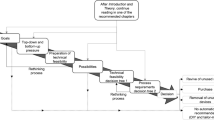Summary
Automation of an analytical technique can be accepted only when the whole procedure can be optimized. Examples amples are given how to optimize HPLC, and how misleading the classical data of theoretical plate height or plate numbers are. It is shown, how well the “abt concept” helps to optimize HPLC and to understand the results. HPTLC is too powerful for full automation due to its large sample throughput at an analytical separation speed of 24 samples in 30 seconds. HPLC and HPTLC are compared with respect to full or partial automation.
Zusammenfassung
Ohne vorherige Optimierung darf eine analytische Methode nicht automatisiert werden. Ein theoretisches und praktisches Konzept, nach welchem HPLC bezüglich Trennleistung und Trennvermögen optimiert werden kann, wird gegeben. Es zeigt, daß klassische Kennzahlen wie die Zahl theoretischer Trennstufen oder Bodenhöhenwerte außerstande sind, den tatsächlichen Leistungsstand einer chromatographischen Methode sachgerecht zu beurteilen. Das “abt-Konzept” hingegen beschreibt Stand und Trend bei der Optimierung perfekt. Hochleistungs-Dünnschicht-Chromatographie wird man wegen ihrer so schon extremen Probenkapazität—im schnellsten Falle derzeit 24 Proben in 30 Sekunden getrennt-nicht vollautomatisieren können. Dennoch werden beide Methoden bezüglich Automatisierung verglichen.
Similar content being viewed by others
Literatur
I. Molnar, Berlin, Privatmitteilung, Jan. 1979.
A. S. Said, HRC & CC2, 93–94 (1979).
R. E. Kaiser, HRC & CC2, 91–92 (1979).
E. Oelrich undR. E. Kaiser, Optimisierung in der HPLC, Reihe Methoden der Chromatographie, Dr. A. Hüthig Verlag, Heidelberg-Basel-New York (1970), erscheint im Mai 1979.
R. E. Kaiser, Chromatographia9, 337–352, 463–467 (1976).
G. Guiochon, Chromatographia11, 249–256 (1978).
R. E. Kaiser, Chromatographia11, 257–259 (1978).
R. Stock, Chromatographia11, 565 (1978).
J. F. K. Huber, Diskussionsbeitrag in Sandoz AG, Basel 1979, HP-SandozTagung Automation der HPLC.
R. E. Kaiser, HRC & CC1, 164–168 (1978).
S. Hara, R. E. Kaiser undA. Zlatkis (eds.), Instrumentalized High-Performance TLC, Dr. A. Hüthig Verlag, Heidelberg-Basel-New York (1980), in Vorbereitung.
I. International Symposium on HPTLC Mai 1980, Bad Dürkheim, in Vorbereitung.
H. Hulpke, Diskussionsbeitrag wei bei [9] Diskussionsbeitrag in Sandoz AG, Basel 1979, HP-Sandoz Tagung Automation der HPLC s.a. [11]S. Hara, R. E. Kaiser undA. Zlatkis (eds.), Instrumentalized High-Performance TLC, Dr. A. Hüthig Verlag, Heidelberg-Basel-New York (1980), in Vorbereitung.
Author information
Authors and Affiliations
Rights and permissions
About this article
Cite this article
Kaiser, R.E. Vergleich von HPLC mit HPTLC unter dem Aspekt der Automatisierung. Chromatographia 12, 338–344 (1979). https://doi.org/10.1007/BF02259150
Issue Date:
DOI: https://doi.org/10.1007/BF02259150




